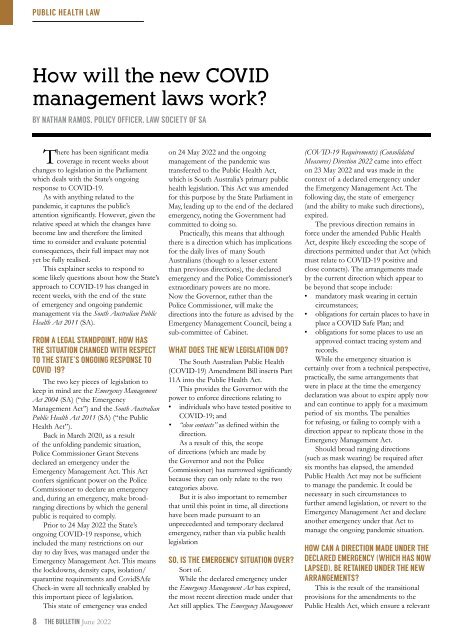LSB June 2022 LR
Create successful ePaper yourself
Turn your PDF publications into a flip-book with our unique Google optimized e-Paper software.
PUBLIC HEALTH LAW<br />
How will the new COVID<br />
management laws work?<br />
BY NATHAN RAMOS, POLICY OFFICER, LAW SOCIETY OF SA<br />
There has been significant media<br />
coverage in recent weeks about<br />
changes to legislation in the Parliament<br />
which deals with the State’s ongoing<br />
response to COVID-19.<br />
As with anything related to the<br />
pandemic, it captures the public’s<br />
attention significantly. However, given the<br />
relative speed at which the changes have<br />
become law and therefore the limited<br />
time to consider and evaluate potential<br />
consequences, their full impact may not<br />
yet be fully realised.<br />
This explainer seeks to respond to<br />
some likely questions about how the State’s<br />
approach to COVID-19 has changed in<br />
recent weeks, with the end of the state<br />
of emergency and ongoing pandemic<br />
management via the South Australian Public<br />
Health Act 2011 (SA).<br />
FROM A LEGAL STANDPOINT, HOW HAS<br />
THE SITUATION CHANGED WITH RESPECT<br />
TO THE STATE’S ONGOING RESPONSE TO<br />
COVID-19?<br />
The two key pieces of legislation to<br />
keep in mind are the Emergency Management<br />
Act 2004 (SA) (“the Emergency<br />
Management Act”) and the South Australian<br />
Public Health Act 2011 (SA) (“the Public<br />
Health Act”).<br />
Back in March 2020, as a result<br />
of the unfolding pandemic situation,<br />
Police Commissioner Grant Stevens<br />
declared an emergency under the<br />
Emergency Management Act. This Act<br />
confers significant power on the Police<br />
Commissioner to declare an emergency<br />
and, during an emergency, make broadranging<br />
directions by which the general<br />
public is required to comply.<br />
Prior to 24 May <strong>2022</strong> the State’s<br />
ongoing COVID-19 response, which<br />
included the many restrictions on our<br />
day to day lives, was managed under the<br />
Emergency Management Act. This means<br />
the lockdowns, density caps, isolation/<br />
quarantine requirements and CovidSAfe<br />
Check-in were all technically enabled by<br />
this important piece of legislation.<br />
This state of emergency was ended<br />
8<br />
THE BULLETIN <strong>June</strong> <strong>2022</strong><br />
on 24 May <strong>2022</strong> and the ongoing<br />
management of the pandemic was<br />
transferred to the Public Health Act,<br />
which is South Australia’s primary public<br />
health legislation. This Act was amended<br />
for this purpose by the State Parliament in<br />
May, leading up to the end of the declared<br />
emergency, noting the Government had<br />
committed to doing so.<br />
Practically, this means that although<br />
there is a direction which has implications<br />
for the daily lives of many South<br />
Australians (though to a lesser extent<br />
than previous directions), the declared<br />
emergency and the Police Commissioner’s<br />
extraordinary powers are no more.<br />
Now the Governor, rather than the<br />
Police Commissioner, will make the<br />
directions into the future as advised by the<br />
Emergency Management Council, being a<br />
sub-committee of Cabinet.<br />
WHAT DOES THE NEW LEGISLATION DO?<br />
The South Australian Public Health<br />
(COVID-19) Amendment Bill inserts Part<br />
11A into the Public Health Act.<br />
This provides the Governor with the<br />
power to enforce directions relating to<br />
• individuals who have tested positive to<br />
COVID-19; and<br />
• “close contacts” as defined within the<br />
direction.<br />
As a result of this, the scope<br />
of directions (which are made by<br />
the Governor and not the Police<br />
Commissioner) has narrowed significantly<br />
because they can only relate to the two<br />
categories above.<br />
But it is also important to remember<br />
that until this point in time, all directions<br />
have been made pursuant to an<br />
unprecedented and temporary declared<br />
emergency, rather than via public health<br />
legislation<br />
SO, IS THE EMERGENCY SITUATION OVER?<br />
Sort of.<br />
While the declared emergency under<br />
the Emergency Management Act has expired,<br />
the most recent direction made under that<br />
Act still applies. The Emergency Management<br />
(COVID-19 Requirements) (Consolidated<br />
Measures) Direction <strong>2022</strong> came into effect<br />
on 23 May <strong>2022</strong> and was made in the<br />
context of a declared emergency under<br />
the Emergency Management Act. The<br />
following day, the state of emergency<br />
(and the ability to make such directions),<br />
expired.<br />
The previous direction remains in<br />
force under the amended Public Health<br />
Act, despite likely exceeding the scope of<br />
directions permitted under that Act (which<br />
must relate to COVID-19 positive and<br />
close contacts). The arrangements made<br />
by the current direction which appear to<br />
be beyond that scope include:<br />
• mandatory mask wearing in certain<br />
circumstances;<br />
• obligations for certain places to have in<br />
place a COVID Safe Plan; and<br />
• obligations for some places to use an<br />
approved contact tracing system and<br />
records.<br />
While the emergency situation is<br />
certainly over from a technical perspective,<br />
practically, the same arrangements that<br />
were in place at the time the emergency<br />
declaration was about to expire apply now<br />
and can continue to apply for a maximum<br />
period of six months. The penalties<br />
for refusing, or failing to comply with a<br />
direction appear to replicate those in the<br />
Emergency Management Act.<br />
Should broad ranging directions<br />
(such as mask wearing) be required after<br />
six months has elapsed, the amended<br />
Public Health Act may not be sufficient<br />
to manage the pandemic. It could be<br />
necessary in such circumstances to<br />
further amend legislation, or revert to the<br />
Emergency Management Act and declare<br />
another emergency under that Act to<br />
manage the ongoing pandemic situation.<br />
HOW CAN A DIRECTION MADE UNDER THE<br />
DECLARED EMERGENCY (WHICH HAS NOW<br />
LAPSED), BE RETAINED UNDER THE NEW<br />
ARRANGEMENTS?<br />
This is the result of the transitional<br />
provisions for the amendments to the<br />
Public Health Act, which ensure a relevant


















